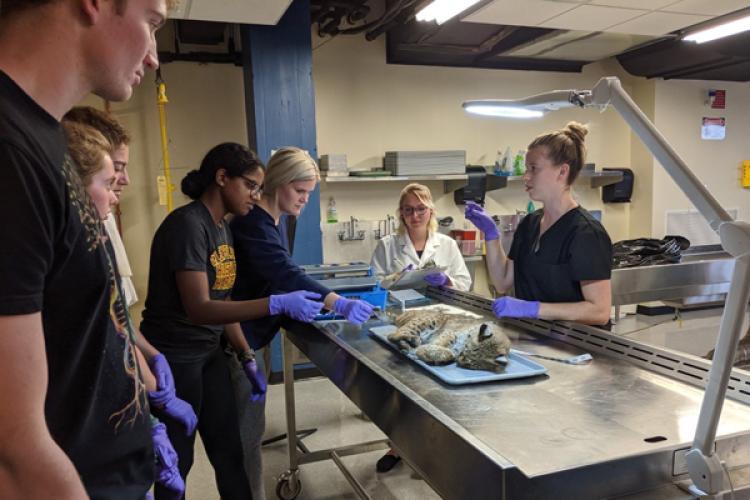
Marissa Dyck awarded American Society of Mammologists' highest award for a graduate student

Biological Sciences doctoral student Marissa Dyck was awarded the 2022 American Society of Mammologists Fellowship, the highest award made to a graduate student member of the society.
Mammals — specifically carnivores such as lynx, wolves, bobcats, and coyotes — are the focus of Dyck's research. She studies ecology and conservation in the United State and Eastern Europe using non-invasive techniques coupled with statistical modeling to assess occupancy, interspecific interactions, and population viability of species.
Dyck has been a member of the American Society of Mammologists (ASM) since 2017 when she was an undergraduate student at the University of Wyoming. She has attended and presented at four ASM conferences, received grants-in-aid from ASM, and currently serves on the Conservation and the African Graduate Student Research Fund committees and as a student representative to the ASM Board of Directors.
Only four years into her Ph.D. in Biological Sciences at Ohio University, Dyck had already been published in journals such as Ecology and Evolution, Mammal Review, Journal of Mammalogy, and Ecology. (See her recent paper: Dracula’s ménagerie: A multispecies occupancy analysis of lynx, wildcat, and wolf in the Romanian Carpathians.)
Her research falls within the intersection of community and population ecology, conservation, and human-wildlife coexistence. Her mentor is Viorel Popescu, associate professor of biological sciences in the College of Arts & Sciences. Their work combines sample collection in the field with heavy use of data analytics.
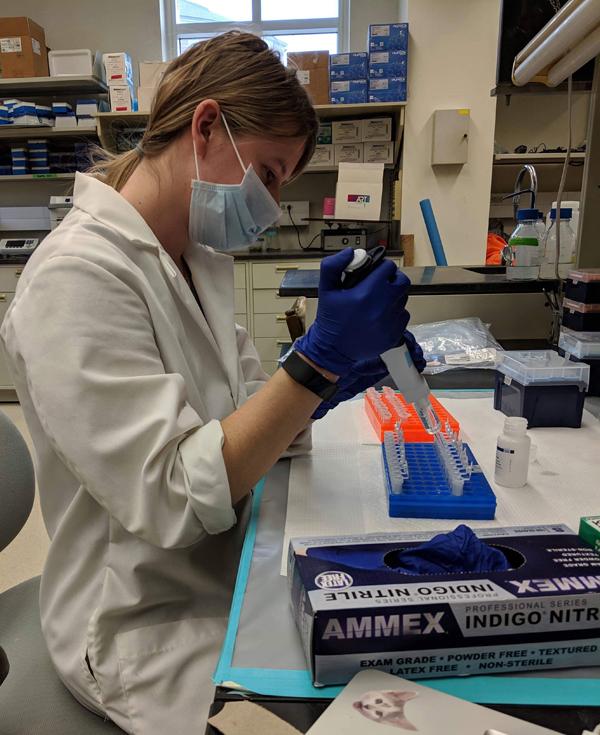
"This allows me to work with a number of really unique and extensive datasets both locally and internationally," Dyck said. "One of the coolest things I’ve gotten to do as a result of this work is travel to Romania to aid in data collection on bears, wolves, lynx and other European carnivores. However, in Ohio I’m working to assess population density and viability of recovering bobcats. I’ve partnered with Ohio Department of Natural Resources to incorporate science into management decisions regarding bobcats and carnivores such as coyotes."
Dyck is passionate about teaching and mentorship. She's already mentored more than 25 undergraduate students and invites students to consider working in the conservation lab.
"I have a really strong passion for field research, data analysis and mentoring students. I got where I am today because of great mentors, and I hope to do the same for other young scientists in whatever capacity I can," she added.
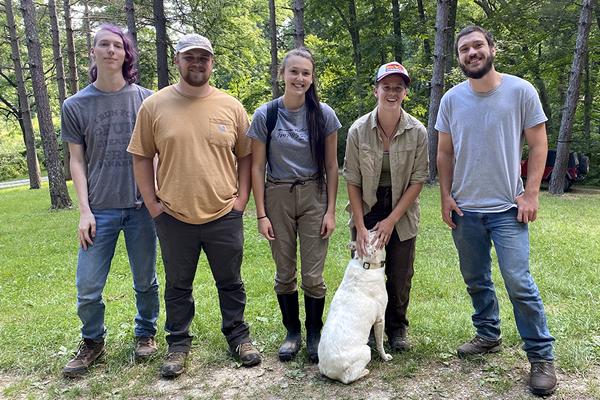
"If there are undergraduates interested in assisting with any of the carnivore work, I am doing or interested please don’t hesitate to contact me. I would love to mentor any student interested in mammals and carnivore ecology and conservation at any commitment or experience level. We can look into various funding options if this is a concern, and I attend multiple conferences a year that are great places to network for jobs and higher education opportunities. To keep up-to-date on the carnivore research both in Ohio and Romania please give me a follow on Twitter @Dyck_ologist," Dyck said.
How did a resident of McMinnville, Oregon, find her way to Ohio University on her way to her dream job as a researcher and mentor actively engaged in the scientific community?
Q&A with Marissa Dyck
Q: Why did you choose Ohio University?
A: I chose to come to OHIO for my Ph.D. for two main reasons: 1) to work with my amazing advisor Dr. Viorel Popescu, whom I had heard great things about before visiting as well as during my interviews, and 2) to conduct research that would allow me to a direct and immediately impact carnivore management and conservation. Part of my dissertation is focused on assessing the density and viability of recovering bobcats in Ohio, which will have implications for a proposed fur trapping season as well as other management decisions. (See her Student Expo video about bobcats.)
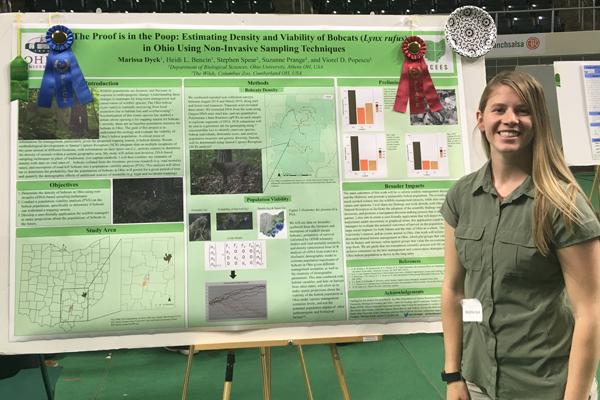
Q: How have you been challenged in the Biological Sciences Department?
A: Pursuing a Ph.D. is always challenging. In particular, the department and university offer a number of grants for student research that have really pushed me to improve my grant writing skills and to be able to convey my research to a broad array of audiences.
As part of my contract, I’ve also taught four different courses at both the undergraduate and graduate level. Teaching is not something I had a lot of experience with before graduate school, so I’ve worked hard to improve my communication and public speaking skills significantly.
I’ve also worked with a number of undergraduate students to conduct necropsies on roadkill bobcats as well as collect, analyze, and present data. Mentoring is something I’m extremely passionate about, but like teaching, I didn’t have much experience with it before graduate school. There are so many eager undergraduates in the department, and are projects can always benefit from more hands, this has really pushed me to be super organized and learn how to coordinate and mentor students effectively, and I hope to continue improving these skills with other interested students in the future.
Q: Which faculty/mentors have been the most influential to you?
A: Obviously, my advisor Dr. Viorel Popescu, has been a huge influence for me. I’ve learned so much from him in the past two years, and I’m grateful for his continued support and mentorship. I couldn’t have asked for a better advisor, and I’m super excited to share the results for some of our work soon.
I have also had the wonderful opportunity to collaborate with a number of other faculty from the BIOS department as well as other departments. Dr. Joseph Johnson in particular has had a huge influence on me. My work on Ohio’s bobcats involves the collection and dissection of roadkill bobcats from Southeast Ohio. Dr. Johnson supported and encouraged me to salvage as many of these specimens as possible for their value in future education, research, and outreach. As a result of this, I’ve gotten to work with Dr. Sabrina Curran (anthropology) and Dr. Lawrence Witmer and Dr. Nancy Stevens (both in the Heritage College of Osteopathic Medicine), who have all graciously contributed time and resources to skeletonize and preserve these specimens in hopes of developing a reference collection to be displayed and stored at the Ohio Museum Complex. These are just a few of the wonderful faculty and mentors I’ve had the privilege to know thus far, and I’m sure there will be many more fruitful collaborations in the coming years.
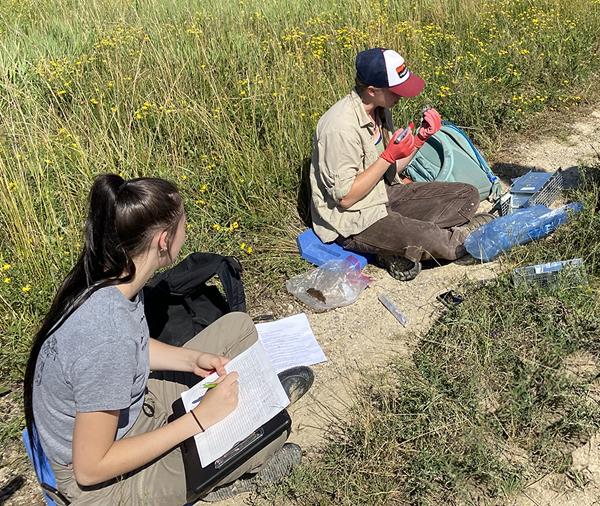
Q: What are your favorite opportunities that you have taken advantage of?
A: I have really enjoyed participating in the outreach opportunities that Biological Sciences Graduate Society (BSGS) coordinates. BSGS has partnered with local libraries to bring hands-on science activities to Ohio’s youth. On the occasions when I have had the opportunity to participate, I have used skin and skull specimens of mammals to showcase the diversity of Ohio’s mammalian fauna. It’s really cool to see the kids naming all the different animals and getting to look at them up close and really appreciate the diversity and individuality of each species.
I’m a member of the Biological Sciences Graduate Society and will be running for an officer position for next year, and I lead a weekly yoga session centered around improving graduate students' mental health. I’m also a member of Climb Athens LLC, a local climbing non-profit focused on providing a supportive community and climbing opportunities for climbers of all levels.
Q: What’s your favorite thing about the Biological Sciences Department?
A: The graduate student community is phenomenal. Everyone was very welcoming of myself and my service dog, Sadie, when I arrived. It really made the transition to a new place so much easier. I have never had a better support system than I do right now with the students I’ve met in the BIOS department. Even during this pandemic, we find ways to support and encourage one another.
